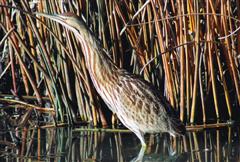Bittern - American
Stake Driver, Thunder Pumper, Mire Drum Scientific Name: Botaurus lentiginosus
Tue, 29th April, 2025 - 4:12 pm GMT
Sponsor Ads:

Alternative Name
Stake Driver, Thunder Pumper, Mire Drum Scientific Name: Botaurus lentiginosusBasic Info
The American Bittern is a heron-type bird of about 34 inches in height. The wingspan may comprise 50 inches! Its body is stockier than that of other heron species, as is its white neck. The legs of the American Bittern are relatively short. These birds generally have brown plumage that is covered in fine black speckles. Its undersides are streaked with brown and white feathers. The American Bittern has a characteristic black area of feathers, which covers the sides of its neck and extends up to its eye. The wings are also black, but this may be difficult to deduce unless the bird is in flight.
Health
American Bitterns are generally solitary, or found with their life-mates. In the wild, they eat crayfish, amphibians, and other aquatic invertebrates, and their captive diet should reflect this. Breeding Usually, breeding begins in May, when female American Bitterns arrive at the wetlands they usually breed in, and find the mate they have bred with in years before. She constructs a nest of water vegetation like reeds or tufted marsh plants. It is usually four or five centimeters deep. Three to seven eggs are laid one each day in the morning, and incubation generally lasts between 24 and 28 days. The female American Bittern broods and raises the young. Although they may leave the nest between one and two weeks of age, they still return to parents to be fed until they are about four weeks old.Habitat
They are usually found in areas of heavy vegetation, in freshwater wetlands or along shorelines.Behavior
The American Bittern is a large, lovely bird whose haunting voice has captivated those within hearing range for years. Unfortunately, these beautiful herons are disappearing along with the wetland areas of North America that they inhabit. American Bitterns are migratory birds and usually range from middle to northern regions of North America in summer and middle to southern regions in colder months. Bitterns living in warmer areas, however, may not always migrate. American Bitterns will disguise themselves from both predators and prey by standing with their necks erect, bills pointing upward. In this way, with their camouflaging coloration, they are difficult to distinguish from surrounding reeds! Generally, when prey moves by it, the American Bittern will seize it quickly. American Bitterns have "eerie" voices, and have been called a variety of names reflecting the strangeness of the sound, like Mire Drum or Thunder Pumper!Origin
North AmericaHistory
American Bitterns, true to their name, are found in America! Their range extends up through Canada. The American Bittern is declining in number, due to habitat loss and pollution. Sadly, it is a threatened species.Common Foods
These birds usually eat amphibians, invertebrates, and fish, although they may also take small mammals.Sponsor Ads:
Of those teaching in today's schools, 80 percent are paid twice what they are worth and 20 percent are paid half what they are worth. -- Unknown
Bittern - American
Coded by: BGID® | ALL RIGHTS RESERVED Copyright © 2000-2025
Disclaimer | Privacy | Report Errors / Contact | Credits








 Preparing For China. China is growing their military. China Military Technology - can it keep up with the US?
Preparing For China. China is growing their military. China Military Technology - can it keep up with the US?  versus
versus 

 versus
versus 
 This Thread is about the North Korean Military itself - the kind of army, navy, and air force they have.
This Thread is about the North Korean Military itself - the kind of army, navy, and air force they have. 
 versus
versus 
 versus
versus  versus
versus